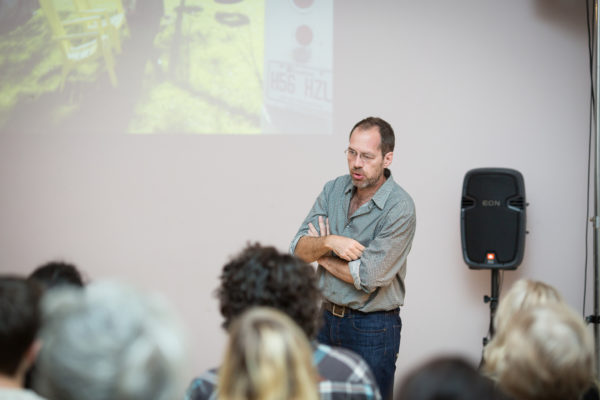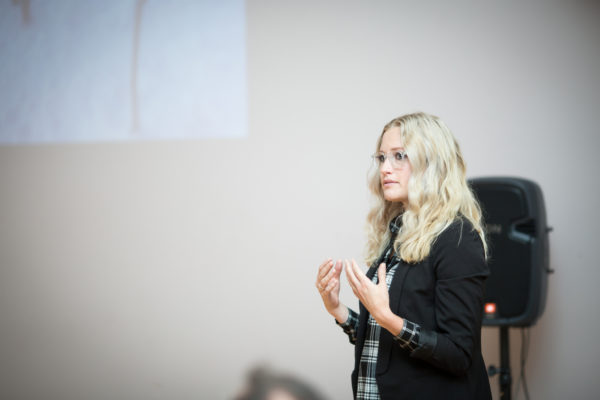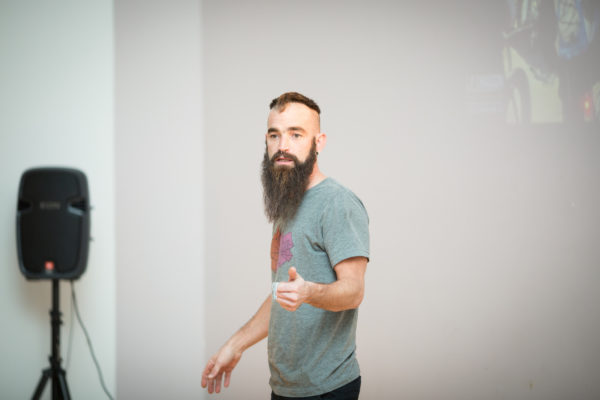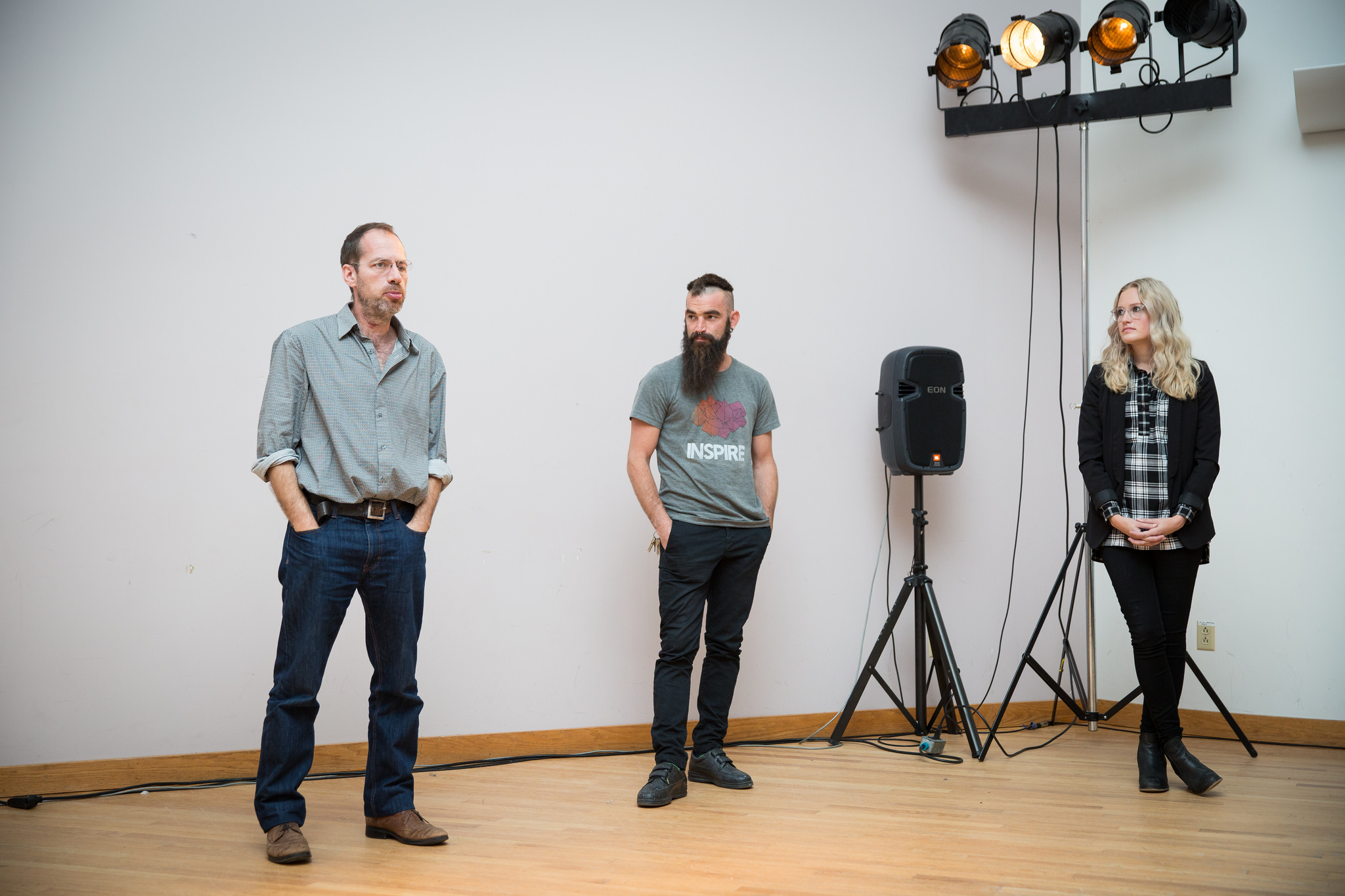On September 26, at the Symposium’s round table on approaches to non-permanent public art works, several diverging points of view and objectives were presented and discussed. Among those, some of the most interesting questions were those surrounding the relationship of the organizers to the artists and to their public, as well as questions about trust, freedom, and non-permanence.
Who is this for?
Questions of relationships and loyalty
One can never please everyone, and no matter how wide your desired appeal, one must always know their audience, their market, their public, or their community. The moderator Jean-Pierre Caissie addressed this question head on, asking each of the panelists about their relationships with the artists they worked with, their public, their city, their funders, and where their loyalties stood.
Martin Dufrasne asserted that at Dare-Dare, an artist run centre in Montreal, their loyalties stand first and foremost with the artists. Their selection committee is made up of seven artists, and once an artist is selected, they give the artist carte blanche to choose their location and to define their project. The goal at Dare-Dare is to use the public space as a research laboratory for experimentation and creation of new works and new methods of working. Renewal and experimentation are key. Their role as organizers is to support the artist and to facilitate the artist’s project by negotiating rights, licensing, and permissions as necessary to create their works. When putting out a call for artists, it is the artists who propose the space, and then it is the role of Dare-Dare to take the steps necessary to negotiate access to working in that space. Dare-Dare’s 31-year history gives them a great deal of credibility in these negotiations as it brings with it a certain amount of credibility and legitimacy that property owners and city administrators can trust.
Matt Williston described the festival Inspire as a gift to the city of Moncton. He explained that first and foremost, their goal is to bring more art to more people. In order to do this, the festival organizers first choose the location for an artwork, and then they work with the landlord of the building, to select an artist whose style they like. They show the landlord samples of work by two or three artists, and it is the property owner who has the final say when it comes to selecting the artist. Once an artist is selected, the organizers send the artist a photo of the space they are assigned to use. As such, the festival is described as a gift to the city, that is made possible through the work of the artists. The festival, then is for the city first, and its loyalty lies with the property owners rather than with the artists, who function more as contracted workers or commissioned graphic artists.
Christiana Myers explains that Third Shift, Saint John’s only after dark public art event, works closely with the artists, but still has to walk a line of building relationships with the city and sponsors. Like festival Inspire, Third Shift is still young and just finished its second edition, and so solid lines of communication and relationship building are key when it comes to site specific public art works. Third Shift is a one night only public art event, similar to the popular Nuit Blanche festivals seen in other cities. Many cities around the world, large and small, boast of organizing such elaborate festivals of spectacle. Paris, Montreal, Toronto and others run actual “Nuit Blanche” events, while cities in Atlantic Canada organize smaller versions such as Lumière in Sydney, Antigonight in Antigonish, Art in the Open in Charlottetown, and Nocturne in Halifax. Third Shift is the only after dark contemporary art festival in New Brunswick. This is why relationship building, partnerships, and collaborations are so important to making such an event possible. Given the fact that they are essentially breaking ground for this type of one-night-only spectacle based ephemeral and non-permanent contemporary art work in Saint John, they work hard to find an equilibrium and a balance of power between the artists and the sponsors, making sure that sponsors are on board, while the artists maintain enough artistic freedom to experiment and try new things that expand their existing practices into new territory.
Who trusts whom?

Questions of freedom and license
Relationships are built on trust. Even in risk taking, there must be a certain degree of trust.
Dufrasne emphasizes how important it is for Dare-Dare to trust the artists and to give them complete freedom. In their particular situation, the city and the public administrators must trust Dare-Dare, and Dare-Dare in turn trusts the artists. This is not always easy to navigate with a centre whose office moves every two to three years into a new quartier or neighborhood where they must begin rebuilding relationships from scratch. It is a constant game of collaboration and negotiation. Trust is immensely important in their work, because the nature of the projects that they program involve supporting artistic practices where they don’t know, and don’t want to know, what’s going to happen. As such, it is a delicate balancing act of reassuring one entity (the city or the property owners) while granting licence and freedom to the other entity (the artist).
The question of trust came up later in the discussion, when André Lapointe, an established artist known for his public art works and stone sculptures, asked Matt Williston about the festival Inspire, and whether in the context of a city with an increasing amount of large scale commercial LED signs and advertising images, they had considered the possibility that there might be a risk that the continual creation of multiple large scale brightly coloured murals every year might potentially eventually contribute to visual pollution in the city over the long run. Rather than addressing the question directly or engaging the topic with thoughtful discussion, Williston simply responded by saying “Trust us. Trust our curating”. So in this case, it is the public who is asked to trust two individual organizers of a new festival, to be the tastemakers for the whole city.
While Dare-Dare also relies on trust from the city and the public, it is a different sort of trust that comes with ephemeral performance work in public spaces that dissipate over days and weeks, than when it comes to large scale brightly painted murals that will last for years.
How long will it last?

Questions of permanence and non-permanence
The term “public art” often conjures images or conceptions of permanent works such as monuments, stone sculptures, or murals. This round table however, is dedicated to the discussion of non-permanent public art work. What defines a non-permanent work, how is one designed, and why bother invest or create a work that will not last.
Christiana Myers explained that the city of St. John is a very old city and already has a lot of permanent monuments and works, so they did not feel a need to add to those. As such, Third Space and Third Shift place an emphasis on creating moments, discoveries, and experiences that will only last a few hours to a few days at a time, but no longer. They are interested in experiences that will inspire the community and create moments of revelation and realization wherein the community members are able to look at mundane things they may have taken for granted in a new light.
When asked about festival Inspire’s approach to permanent versus non-permanent art, Matt Williston replied that “Nothing is permanent”. While true, his response was a somewhat flippant evasion of the ultimate question about the future of their murals, which are designed to last for years, rather than hours or days, like the works at Third Shift or Dare-Dare.
At this point, it is interesting to draw comparisons with the Symposium d’art/nature, where the deterioration and the degredation of the art is taken into consideration during the conception and execution phases of the work. The deterioration of the art work as it returns to nature over time, or the transformation of the artwork by nature, are quite often as much a part of the art work, as the initial execution. Meanwhile with a mural, one has to choose to either invest in maintenance, to retouch it and repair it over time due to weather wear and graffiti, or to allow it to peel chip and be defaced over decades, or alternately to choose a moment in time when it will be painted over completely either returning the wall to a solid colour, or covering it with another mural.
Given Williston’s acknowledgement that “nothing is permanent” it would have been very interesting to hear what their plans are in relationship to the aging of their commissioned murals: whether they intend to maintain them, to allow them to fade gradually, aging like our human bodies, or to paint over them at a specified point in time. These are three very different approaches to the temporality and ephemerality of murals and each one of these approaches has its own unique characteristics and implications for the artwork and for the community. An actual response to the temporal nature of their works could have led to some very interesting discussions. Acknowledging that “nothing is permanent” is one thing, but actually addressing that reality and considering it, is another thing altogether.
Why do it?

Questions of disruption and diversion
Caissie then brought the discussion around to contemplate the nature and purpose of public art in general. Is it the goal of public art to create beauty and decoration? Or is it to bring about social change? Is it the role of public art to cause people to think differently, to have moments of revelation and realization that disrupt their daily routine? Or is its role to create venues for entertainment and escape from the problems of daily life through distraction and diversion?
Martin Dufrasne explains that it depends on who is looking. He hopes Dare-Dare errs more on the side of creating social disruptions that cause everyday people and random passersby to question notions of tourism and spectacle. He says that there is a real danger when an arts organization starts to play a role in raising property values for landlords. At that point they become complicit in a system that can quite easily become problematic and exploitative not only of the artists, but also of the communities where the work is made.
It’s interesting to note here, the role that artist driven activities have historically played in the gentrification of urban areas. As art projects drive up property values, community members with lower incomes are gradually pushed out of those neighborhoods and toward the margins of the city. For many arts organizations that are socially conscious and driven by goals of social justice, it is important therefore to take into account the impact of their work on their communities in the long term and to create works that are sensitive to all classes in their communities.
To this end, Christiana Myers goes on to describe how Third Shift specifically asks their artists to consider the location, the history, and the politics of the region. When they invite artists to participate, they actually encourage them to consider subgroups and communities within the city that they would like to work with and to address. Their view is that it is better to deeply touch and move one small community, than to be noticed or seen by a huge number of people. A question of quality over quantity. Over time, the quantity will build, but instead of massive crowds at generalized events, they will have many small events, and moments experienced by targeted communities who feel a real connection with an artist who made art work either with them, or specifically for them and their community, no matter how small the subgroup or subculture.
When asked whether the goal of festival Inspire was to create disruptions or to promote the city of Moncton, Matt Williston explained that it’s no secret that he has a vision for Moncton to be a cultural hub. Their festival tries to push the limits, but their festival is still very young, it is the same age as Third Shift. So for now they are still stepping lightly, to make sure that their murals are not read as graffiti, because the city and the landlords are always very concerned that the work not be read as graffiti. As such, the festival Inspire needs to keep that line between sanctioned and non-sanctioned art very clear.
Festival Inspire’s commissioned art works may not be inside a traditional “gallery”, inside four white walls with a ceiling, but all of their projects still rely quite heavily on having the boundaries between “art” and “not-art” clearly defined. There is no room for ambiguity in their work with this regard. It is either sanctioned art, or its not art. Williston does clarify that while they make sure their murals are not mistaken for graffiti, that they also don’t do commercials or advertising. In spite of this, he explains that they have to keep the landlords happy, and that the landlords want to make sure that the work is “beautiful”.
This point begs the question: whose beauty are we talking about? Who gets to decide what is beautiful and for whom? Is there only one type of beauty? Does decoration bring about social change in society for the better? Or do traditional concepts of beauty risk falling into the realm of diversion, distraction, and decoration that comforts people into feeling like everything is already fine and nothing needs to change?
Dufrasne joined in with this sentiment, expanding that for Dare-Dare they often find more value in art work that engages in, interacts with, and questions the mundane, and the daily activities of people, rather than focusing on works that are monumental in scale. The number of people attending their events are not nearly as important as the depth of the experiences they create. He finds that it is in the daily activities and routines where people can be the most challenged, inspired, or surprised.
Bringing these considerations back to the Symposium d’art/nature, we can see artists creating new works that are disruptions in nature, but they are not in your face. These works do not demand your attention like giant billboards. In this case, the individual actually has to go and seek them out by entering into the park, but once in the park, the viewer is not only surrounded by and reconnected with nature, but they are also confronted with many subtle disruptions in nature. Sometimes these interventions are so subtle, it is even hard to tell what has been made by the artist, and what was made by nature, and this in and of itself forces the individual to contemplate nature and its relationship to humanity and society.
Biographies
Martin Dufrasne is the director of Dare-Dare in Montreal. An artist fun centre that has been around for 31 years. Since 2004 they have been dedicated primarily to public art. Their office is located in a trailer that is relocated to a new neighboorhood every 2-3 years. Dufrasne holds a bachelor’s degree in environmental design (UQAM) and a multidisciplinary bachelor of arts (UQAC). He mainly expresses his artwork through installations, photography and art action. His pieces challenge the ideas of value, transformation and engagement. Since 1998, along with his solo work, he has been collaborating with the artist Carl Bouchard. Martin’s work has been presented in many collective and solo exhibitions during biennials and performance festivals in Quebec, Canada and abroad.
Matt Williston is co-founder and Creative Director of L’Art ici SVP & Festival Inspire which just wrapped up its second edition in the city of Moncton. Festival Inspire is the newest of three public art festivals that happen in Moncton, and Williston describes it as a festival whose goal is to bring more art to larger crowds of people who might be too intimidated to enter the gallery spaces. Williston returned to Moncton in 2012 after being based in Montreal, while travelling and working the world, since 1999. VJ, DJ, actor, performer, and event organizer, Matthew is well versed in cutting-edge media arts and projection mapping. He continues to push the borders of contemporary and visual arts, bringing with him 20+ years experience in event planning, art and subculture. “Creating spaces that create community” is Willistons main drive, along with living in a creative, colorful and inspiring city
Christiana Myers is the president of the board of directors of Third Space Gallery, located in New-Brunswick’s industrial port city. Third Space is a roving, interdisciplinary exhibition and performance space committed to representing professional contemporary artists. This year the gallery hosted the second edition of Saint John’s only night-time public art event, Third Shift, which sees artists’ work programmed into the city’s interstitial spaces. She was an intern for Saint John’s first international sculpture symposium where she had the opportunity to assist artists in creating large-scale granite sculptures that are now installed in communities around the province. She is also a visual artist and has presented her work in a number of solo and group exhibitions and took on a curatorial role for an exhibition exploring the interpretation of the industrial Maritime landscape in contemporary art.
